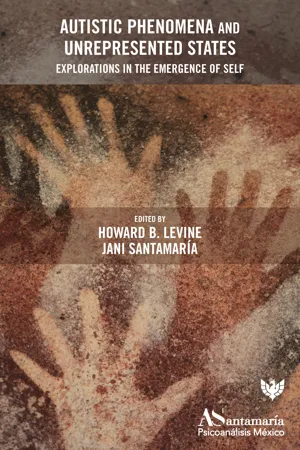
Autistic Phenomena and Unrepresented States
Explorations in the Emergence of Self
- 264 pages
- English
- ePUB (mobile friendly)
- Available on iOS & Android
Autistic Phenomena and Unrepresented States
Explorations in the Emergence of Self
About this book
With contributions from Anne Alvarez, Joshua Durban, Jeffrey L. Eaton, Bernard Golse, Didier Houzel, Howard B. Levine, Suzanne Maiello, Sylvain Missonnier, Bernd Nissen, Marganit Ofer, and Jani Santamaría.
The capacity to create psychic representations is now understood to be a developmental achievement. Without it, meaning cannot be ascertained and this can lead to "psychic voids" and "unrepresented states", which can contribute to the development of autism and autistic spectrum disorders (ASD). Unrepresented states are also implicated and encountered in other, non-autistic, non-neurotic conditions, such as psychosomatic disorders, addictions, perversions, and primitive character disorders. The affects that unrepresented states produce or are associated with are often those of terror, emptiness, annihilation and despair.
The organisation of the psyche consists of psychotic – i.e. unstructured – as well as neurotic parts of the mind; unintegrated as well as integrated areas; and unrepresented areas with little meaning as well as represented states consisting of specific ideas imbued with affect. Given this organisation, we should expect to find both an unstructured and a dynamic unconscious in all patients. This implies that, to some degree, unrepresented and unintegrated states are universal and will exist and be encountered in all of us. Consequently, the opportunities and challenges presented by the understanding and treatment of autism and ASD, where the unrepresented and its consequences (e.g. defensive organisations employed to protect against annihilation anxiety and catastrophic dread) can be encountered may offer us metaphors and clues relevant to aspects of the treatment of all patients, no matter what their dominant diagnoses may be.
Packed with theory and helpful case studies, this carefully edited collection from an international array of experts in the field is essential reading for all practising clinicians.
Frequently asked questions
- Essential is ideal for learners and professionals who enjoy exploring a wide range of subjects. Access the Essential Library with 800,000+ trusted titles and best-sellers across business, personal growth, and the humanities. Includes unlimited reading time and Standard Read Aloud voice.
- Complete: Perfect for advanced learners and researchers needing full, unrestricted access. Unlock 1.4M+ books across hundreds of subjects, including academic and specialized titles. The Complete Plan also includes advanced features like Premium Read Aloud and Research Assistant.
Please note we cannot support devices running on iOS 13 and Android 7 or earlier. Learn more about using the app.
Information
Table of contents
- Cover Page
- Half Title
- Full Title
- Copyright
- Dedication
- Contents
- About the editors and contributors
- Foreword
- CHAPTER ONE: Making the unthinkable thinkable: vitalisation, reclamation, containment, and representation
- CHAPTER TWO: Finding the wavelength: tools in communication with children with autism
- CHAPTER THREE: “Making a person”: clinical considerations regarding the interpretation of anxieties in the analyses of children on the autisto-psychotic spectrum
- CHAPTER FOUR: The birth of emotional experience under the sea: a clinical case
- CHAPTER FIVE: The third topography: a topography of the bond, a perinatal topography
- CHAPTER SIX: Infantile autism: a pathology of otherness
- CHAPTER SEVEN: Multi two-dimensional: on autistic thinking
- CHAPTER EIGHT: From screaming to dreaming: notes on anxiety and its transformation
- CHAPTER NINE: A “felt-self”: aspects of symbolising through psychotherapy
- CHAPTER TEN: The mute voice: autistic enclaves and transgenerational transmission
- CHAPTER ELEVEN: From nothing to being? Technical considerations for dealing with unrepresented states
- Index